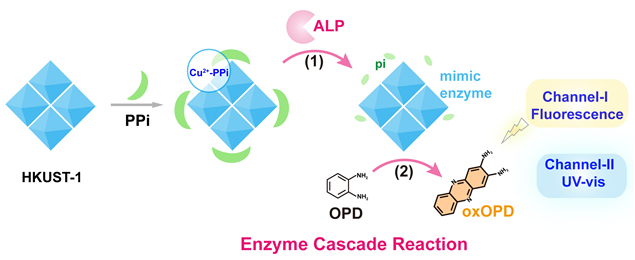[1] Xiong, Y.; Chen, Y.; Ju, H. Acta Chim. Sinica 2019, 77, 1221. (熊莹莹, 陈云龙, 鞠熀先, 化学学报, 2019, 77, 1221.)
[2] Xia, L.; Cheng, Z.; Zhu, H.; Yang, Z. Acta Chim. Sinica 2019, 77, 172. (夏雷, 程震, 朱华, 杨志, 化学学报, 2019, 77, 172.)
[3] Chen, M.; Mu, L.; Cao, X.; She, G.; Shi, W. Chin. J. Chem. 2019, 37, 330.
[4] Wang, W.; Liu, Y.; Shi, T.; Sun, J.; Mo, F.; Liu, X. Anal. Chem. 2020, 92, 1598.
[5] Sun, J.; Liu, F.; Yu, W.; Jiang, Q.; Hu, J.; Liu, Y.; Wang, F.; Liu, X. Nanoscale 2019, 11, 5014.
[6] Barrozo, A.; Duarte, F.; Bauer, P.; Carvalho, A. T. P.; Kamerlin, S. C. L. J. Am. Chem. Soc. 2015, 137, 9061.
[7] Coleman, J. E. Annu. Rev. Biophys. Biomol. Struct. 1992, 21, 441.
[8] Stebbing, J.; Lit, L. C.; Zhang, H.; Darrington, R. S.; Melaiu, O.; Rudraraju, B.; Giamas, G. Oncogene 2014, 33, 939.
[9] Liang, J.; Kwok, R. T. K.; Shi, H.; Tang, B. Z.; Liu, B. ACS Appl. Mater. Interfaces 2013, 5, 8784.
[10] Ronaghi, M.; Haramohamed, S.; Pettersson, B.; Uhlen, M.; Nyren, P. Anal. Biochem. 1996, 242, 84.
[11] Steinberg, K. M.; Okbu, D. T.; Zwick, M. E. Anal. Chem. 2008, 80, 520.
[12] Farre, E. M.; Geigenberger, P.; Willmitzer, L.; Trethewey, R. N. Plant Physiol. 2000, 123, 681.
[13] Dong, P.; Liu, Y.; Zhao, Y.; Wang, W.; Pan, M.; Liu, Y.; Liu, X. Sens. Actuators, B 2020, 310, 127873.
[14] Goswami, S.; Manna, A.; Paul, S.; Aich, K.; Das, A. K.; Chakraborty, S. Dalton Trans. 2013, 42, 8078.
[15] Liu, Y.; Dong, P.; Jiang, Q.; Wang, F.; Pang, D. W.; Liu, X. Sens. Actuators, B 2019, 279, 334.
[16] Zhang, J.; Liu, H.; Meng, L. Chin. J. Org. Chem. 2019, 39, 3132. (张继东, 刘鸿泽, 孟丽, 有机化学, 2019, 39, 3132.)
[17] Hayat, A.; Andreescu, S. Anal. Chem. 2013, 85, 10028.
[18] Wei, H.; Chen, C.; Han, B.; Wang, E. Anal. Chem. 2008, 80, 7051.
[19] Zhao, J. Y.; Chen, G.; Gu, Y. P.; Cui, R.; Zhang, Z. L.; Yu, Z. L.; Tang, B.; Zhao, Y. F.; Pang, D. W. J. Am. Chem. Soc. 2016, 138, 1893.
[20] Liu, X.; Li, Y.; Liang, J.; Zhu, W.; Xu, J.; Su, R.; Yuan, L.; Sun, C. Talanta 2016, 160, 99.
[21] Wang, W.; Zhao, Y.; Jin, Y. ACS Appl. Mater. Interfaces 2013, 5, 11741.
[22] Liu, Y.; Pan, M.; Wang, W.; Jiang, Q.; Wang, F.; Pang, D. W.; Liu, X. Anal. Chem. 2019, 91, 2086.
[23] Liang, H.; Jiang, S.; Yuan, Q.; Li, G.; Wang, F.; Zhang, Z.; Liu, J. Nanoscale 2016, 8, 6071.
[24] Kou, B.; Chai, Y.; Yuan, Y.; Yuan, R. Anal. Chem. 2018, 90, 10701.
[25] Meng, X.; Fan, K.; Yan, X. Sci. China:Life Sci. 2019, 62, 1543.
[26] Li, Z.; Feng, K.; Zhang, W.; Ma, M.; Gu, N.; Zhang, Y. Chin. Sci. Bull. 2018, 63, 2128. (李卓轩, 封开政, 张薇, 马明, 顾宁, 张宇, 科学通报, 2018, 63, 2128.)
[27] Gao, L.; Zhuang, J.; Nie, L.; Zhang, J.; Zhang, Y.; Gu, N.; Wang, T.; Feng, J.; Yang, D.; Perrett, S.; Yan, X. Nat. Nanotechnol. 2007, 2, 577.
[28] Wang, Y.; He, C.; Li, W.; Zhang, J.; Fu, Y. Catal. Lett. 2017, 147, 2144.
[29] Chen, J.; Patil, S.; Seal, S.; McGinnis, J. F. Nat. Nanotechnol. 2006, 1, 142.
[30] Liu, X.; Wang, Q.; Zhao, H.; Zhang, L.; Su, Y.; Lv, Y. Analyst 2012, 137, 4552.
[31] Wang, X.; Hu, Y.; Wei, H. Inorg. Chem. Front. 2016, 3, 41.
[32] Guo, Y.; Li, W.; Zheng, M.; Huang, Y. Acta Chim. Sinica 2014, 72, 713. (郭颖, 李午戊, 郑敏燕, 黄怡, 化学学报, 2014, 72, 713.)
[33] Cheng, H.; Zhang, L.; He, J.; Guo, W.; Zhou, Z.; Zhang, X.; Nie, S.; Wei, H. Anal. Chem. 2016, 88, 5489.
[34] Wang, Q.; Zhang, X.; Huang, L.; Zhang, Z.; Dong, S. Angew. Chem., Int. Ed. 2017, 56, 16082.
[35] Xie, J.; Cao, H.; Jiang, H.; Chen, Y.; Shi, W.; Zheng, H.; Huang, Y. Anal. Chim. Acta 2013, 796, 92.
[36] Long, J. R.; Yaghi, O. M. Chem. Soc. Rev. 2009, 38, 1213.
[37] Wang, H.; Yuan, S.; Zhou, M.; Guo, L. Electroanalysis 2020, 32, 648.
[38] Zhao, Y.; Pan, M.; Liu, F.; Liu, Y.; Dong, P.; Feng, J.; Shi, T.; Liu, X. Anal. Chim. Acta 2020, 1106, 133.
[39] Yang, Z. R.; Wang, M. M.; Wang, X. S.; Yin, X. B. Anal. Chem. 2017, 89, 1930.
[40] English, J. B.; Martell, A. E.; Motekaitis, R. J.; Murase, I. Inorg. Chim. Acta 1997, 258, 183.
[41] Huo, J.; Brightwell, M.; Hankari, S. E.; Garai, A.; Bradshaw, D. J. Mater. Chem. A 2013, 1, 15220.
[42] Zhu, Q.; Chen, Y.; Wang, W.; Zhang, H.; Ren, C.; Chen, H.; Chen, X. Sens. Actuators, B 2015, 210, 500.
[43] Ren, X.; Liu, J.; Ren, J.; Tang, F.; Meng, X. Nanoscale 2015, 7, 19641.
[44] Liang, H.; Lin, F.; Zhang, Z.; Liu, B.; Jiang, S.; Yuan, Q.; Liu, J. ACS Appl. Mater. Interfaces 2017, 9, 1352.
[45] Chen, M.; Wang, Z.; Shu, J.; Jiang, X.; Wang, W.; Shi, Z. H.; Lin, Y. W. Inorg. Chem. 2017, 56, 9400.
[46] Gao, Z.; Deng, K.; Wang, X. D.; Miró, M.; Tang, D. ACS Appl. Mater. Interfaces 2014, 6, 18243.
[47] Lee, D. H.; Kim, S. Y.; Hong, J. I. Angew. Chem., Int. Ed. 2004, 43, 4777.



